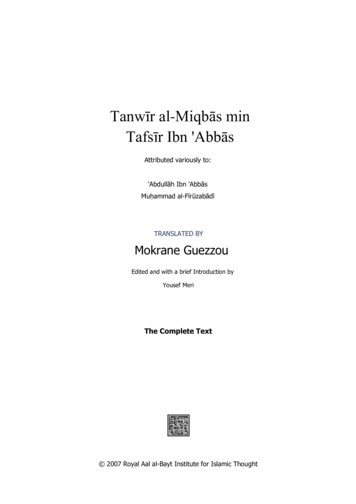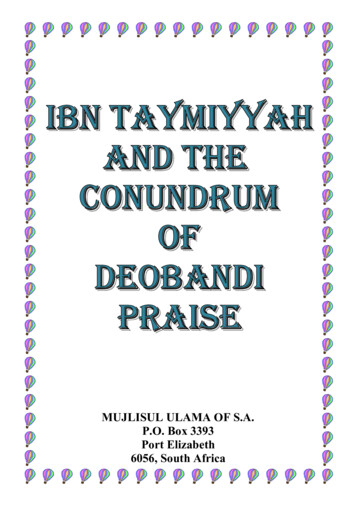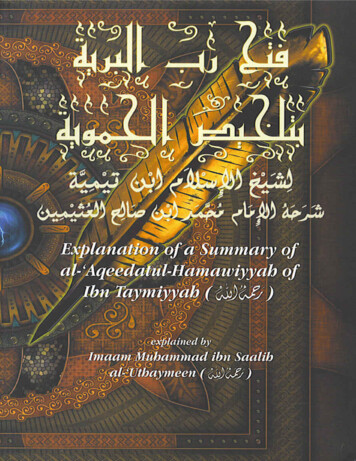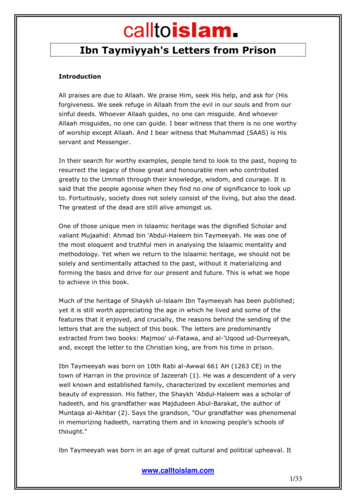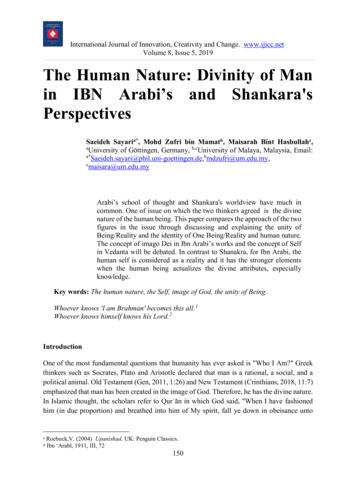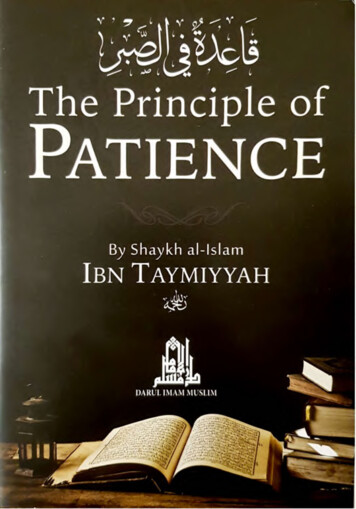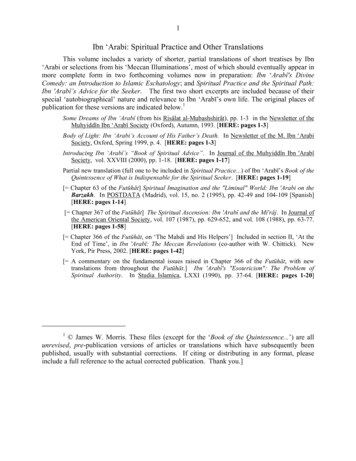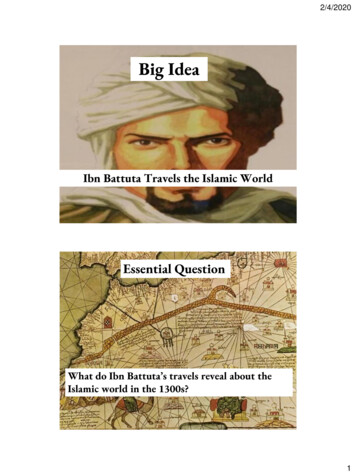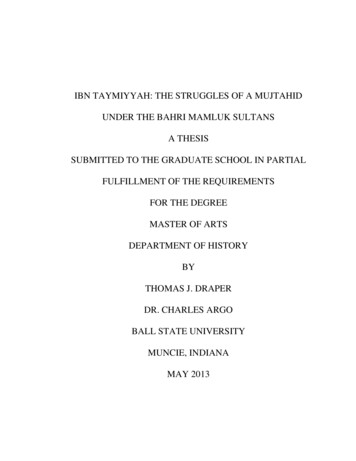
Transcription
IBN TAYMIYYAH: THE STRUGGLES OF A MUJTAHIDUNDER THE BAHRI MAMLUK SULTANSA THESISSUBMITTED TO THE GRADUATE SCHOOL IN PARTIALFULFILLMENT OF THE REQUIREMENTSFOR THE DEGREEMASTER OF ARTSDEPARTMENT OF HISTORYBYTHOMAS J. DRAPERDR. CHARLES ARGOBALL STATE UNIVERSITYMUNCIE, INDIANAMAY 2013
I.II.III.IV.V.VI.VII.VIII.IX.Introductiona. Structure of Paperb. Early Life and Educationc. The Activism of Ibn Taymiyyahd. Scope of Papere. Ijtihad Causal to IncarcerationHistoriographya. Overviewb. Contemporary Arab Biographersc. Marginalization in Arab Historyd. Nineteenth Century European Polemice. Henri Laoustf. Ideologue of Modern Radicalsg. Questioning Earlier Assumptionsh. Recent QuestionsIjtihada. Introductionb. Definitionsc. Problems with Definitionsd. Change over Timee. Hanbalism and Traditionalist PerspectiveIbn Taymiyyah and Ijtihada. His Perceptionb. Contemporary Authority of His Credentialsc. Modern Recognition as Mujtahidd. Apogee of Career and IjtihadContextualization of Bahri Mamluk Sultanatea. Tenuous Nature of Bahri Mamluksb. Dynamic of Taymiyyah and Qalawunc. Trials and Incarcerationsd. Conflict of Mamluk and Taymiyyan GoalsIncarceration for Ijtihada. Threat to Mamluk Authorityb. Qalawun Edict Mentions Ijtihadc. Social, Political, and Legal Threat ofd. Triple Divorce was 81001021031061091102
I. INTRODUCTIONSTRUCTURE OF PAPERThis study will initially introduce Ibn Taymiyyah (1263 – 1328 A.D.) in the firsttwo chapters while contextualizing his position in Islamic history, geography, andhistoriography.1 Taqi al-Din Shaykh al-Islam Ahmad Ibn Taymiyyah (d. 1323) was amedieval scholar of Islam.2 He lived after the fall of the caliphate of the AbbasidDynasty based in Baghdad. He was contemporary to the Mongol invasions in formerAbbasid territories in Mesopotamia and the Levant. His writing constituted an enormouscontribution to Islamic Law (fiqh). While a central figure in Sunni Islam, Taymiyyahheld lesser interest for scholars of Middle Eastern History in the last two centuries.Avicenna (Ibn Sina d. 1037) and Averroes (Ibn Rushid d. 1198) drew attention for their1All dates hereafter can be considered as A.D. unless otherwise noted. This follows the conventionestablished in history approximately sixteen centuries prior. Dates according to the Islamic calendar willbe signified with the after hijra designation of A.H.2His entire name including his title and kunya was Sheikh al Islam Taqi al Din Abu al-Abaas Ahmad ibnAbd al-Halim Ibn Taymiyyah. This phrase, son of Taymiyyah, is not fully understood but might referencea location or honor his aunt.3
writings and thought, while Taymiyyah - when considered - was examined for hispolemics and confrontations with his religious opponents. The adoption of his theologyby Wahhabis, modern radicals whose terror attacks in Riyadh and New York are inspiredby his writings, as well as the seven hundredth anniversary of his death has created amodern revival in his theology.3Ibn Taymiyyah was born in the village of Harran, Mesopotamia in the year 1263(661 A.H.) to a Kurdish mother and Arab father. His life, thought, and work werefrequently out of place with his milieu. He formed legal rulings for a medieval audience,admired Muhammad and the prior generations of seventh-century Islam, yet the audiencehe most significantly influenced was modern post-colonial Islam. The collapse of theAbbasid Caliphate (1258) preceded him and the ascendancy of the Turkic Ottomandynasty succeeded him. His family fled rural Harran at the approach of the Mongolarmies in 1268, leaving the prestigious Hanbali heritage of grandfather, uncle, andfather’s legal writing and authority behind, to live in urban Damascus. Damascus hadbeen an important city in first century Christianity, the former capital of the UmayyadCaliphate (665 – 750), and a historic center of culture and education. The family residedin modern Syria that bordered eastern Mongol threats and western Mamluk relief in theform of the sultan’s armies in Egypt.Taymiyyah’s family deserves special attention in understanding the circumstancesof his day, particularly the family’s relocation in Damascus in response to Mongolinvasions. His paternal grandfather Majd al-Din, father Abd al-Halim, and uncle Fakhr3Muhammad Wahhab (d. 1792) founded the modern Saudi state and relied heavily on Taymiyyah’semphasis on texts that was typical for the people of tradition (ahl al-hadith). Wahhabism is the religiousinfluence Wahhab had as a tribal leader that is pervasive in Saudi Arabia today.4
al-Din were widely respected for their knowledge of shari’a law in Harran among theHanbali majority. In Damascus, Taymiyyah would continue his family’s Hanbalitraditions as Shaykh al-Islam Taqi al-Din Abu al-Abaas Ahmad ibn Abd al-Halim ibnTaymiyyah. He earned the title of Shaykh al-Islam for mastering traditions, such as thoseMajd al-Din had recorded, continuing the family’s emphasis on basing decisions onIslamic texts (na’ss) as the people of traditions (ahl al-hadith). This title was earned intaking over his father’s role as teacher at his Islamic school and for mastering manyaspects of Islamic sciences and arts. His family provided him an early education thatresulted in him eclipsing his peers in the Islamic Arts and Sciences. As his life began inan era of political and religious conflict, he chose to base his ideology and thought on theclassical era and its writings and teachings from the earliest authoritative generations ofIslam (salaf). He was not content to examine and study numerous medieval copies ofninth-or tenth-century Islamic law nor only the writings of Hanbal, Hanaf, Malik, orShafi - the mujtahids who founded the four major schools of Islam.4 He focused on theIslamic texts (na’ss) of first-century Islam to purify and protect his thirteenth-centuryIslamic community (umma). He would, in turn, affect Islamic thought and culture intomodern times.Taymiyyah experienced multiple and lengthy imprisonments by the Egyptianthirteenth-fourteenth-century Islamic authority. My hypothesis is that his use ofindependent reasoning (ijtihad) in matters of law had direct causation to his eventual4Mujtahid ( )مج تهد is a verbal stem derived from the Arabic tri-consonantal j-h-d, with the prefix “mu”meaning “one who” as in a Muslim is “one who” submits in Islam. A mujtahid is one who measures up tostandards of knowledge of the arts and sciences of Islam and is able to reason (ijtihad) to ascertain theappropriate issues involved in a legal case, recognize the appropriate Islamic sources to make adetermination of a case, be aware of legal schools decisions and determine whether the case involves anunprecendented issue. The mujtahid must strive in his best efforts to correctly make a ruling.5
death in prison. These first two chapters are significant for narrowing Islamic history tothe appropriate time, culture, location, and development of historical writing onTaymiyyah. Islam did not remain static from its Arabian inception in the seventhcentury. Neither was cosmopolitan Cairo comparative to Mecca or Medina, thebirthplaces of Islam. The Cairo community was more ethnically diverse, with greatersocial mobility possible by slaves, converts, and minorities in Taymiyyah’s milieu.Understandably, the systems and methods of Islamic law evolved as well. Seven hundredyears of historical writing since have also demonstrated clearer and richer perceptions onhim. The first chapter explains his position in the history of Islamic jurisprudence as ahighly trained scholar by his family and legal school. It locates him at a time after thefall of the commander of the faithful (caliph) in 1258 Baghdad, Caliph Mustasim, and theAbbasid Dynasty. I will explain how a diminished aspect of a strong or centralizedpolitical and religious authority after Muhammad (d. 632), under the successive fourcaliphs (rashidun) and the subsequent Ummayad and Abbasid dynasties, resulted in areligious and political vacuum. Initially, authority existed in the religious and militaryleadership of Muhammad, to succeeding generations and their leaders, then to thereligious, but politically effete leaders of the four schools or Madhhab of Islamic Law.Unlike the aggressively expansionist policies under these Islamic governments such asthe jihad war of the Ummayads, the Islamic government of Taymiyyah’s time period, theBahri Mamluk Sultanate of Egypt, suffered territorial losses to Crusader armies fromEurope and Mongol armies from Asia. As a Sultanate was held responsible for theincrease and spread of Islamic faith, this curtailing of the land subject to Islamic authorityand its laws challenged the legitimacy and stability of the Bahri Mamluk government.6
This politically and religiously vulnerable government was further destabilized bysubstantial religious, ethnic, social, and legal diversity in its population consequent to theincursions of the Crusaders and Mongols. Chapter one ends by suggesting that theindependent reasoning (ijtihad) of Taymiyyah held potential to destabilize the tenuousBahri Mamluk government. His particular beliefs and doctrines regarding Islamicworship and law are generally accepted to be the cause of his imprisonments.Chapter two is a historiography on Taymiyyah that begins with observations byhis peers and ends with perspectives of modern scholars. This will show a historicalfigure often overlooked and misrepresented. It will clarify his priorities, methods, andbeliefs, especially his emphasis on submission to Allah as dictated by the Islamic texts.Islam, similar to Judaism and Christianity before it, held that the one who created allthings has spoken to his creation. Prophets received and transmitted sacred narratives,messages, and scriptures and, in various ways, then transmitted these into sacred texts. InIslam, Muhammad observed a golden plate that descended from heaven and received theportions of the Quran over a period of twenty-two years. As he recited Allah’s wordsunder the care of the archangel Jibril, he, and those he taught, memorized this recitation(Quran derives from the verb “to recite”). Ibn Taymiyyah relied on recitations collatedby Uthman (d. 646), the fourth caliph, and the accounts attributed to the actions orsayings of Muhammad. Ibn Taymiyyah observed and taught these texts as canonical orauthoritative. While he observed additional components and methods as authoritative,Ibn Taymiyyah stressed the texts (na’ss) of Islam. The Quran is the progressiverevelation that Muhammad recited from 610 – 632. Ahadith (hadith singular) are thewritten accounting of what came to be written about what Muhammad reportedly said7
and did. They occur in a hierarchy from highly reliable, reliable, questionable, and weakor fabricated. These two authoritative textual sour5ces primarily guided legal decisionsTaymiyyah made as a Muslim judge. Early Islamic traditions and modern scholarshipattest to his allegiance to Allah and independent reasoning based on these texts. Hisprimary mission was to submit to and worship Allah, as he discovered what Allahproscribed and prohibited, explains his willingness to defy political or religious authoritythat did not align with adherence to his two authoritative sources of the Quran andHadith.Chapter three demonstrates the importance of understanding the concept ofIslamic independent reasoning that will be referred to as ijtihad. Etymology on this termexhibits significant changes in meaning and definition that also involve evolutions in itsacceptance and utility from the seventh-century origins of Islamic jurisprudence untiltoday. It is not possible to accurately answer whether Taymiyyah practiced independentreasoning, let alone was imprisoned for it, if we do not identify ijtihad’s definition,acceptability and use at a precise time in Islamic history. This chapter clarifies thetechnical term of independent reasoning (ijtihad) in its etymological evolution andprovides an understanding of it relative to Taymiyyah and his contemporaries. Chapterfour demonstrates Taymiyyah’s approval of and use of this concept. The chapter alsoincludes descriptions of what level or type of mujtahid he was. Taymiyyah rankshimself, as do his contemporaries and others, as having attained the highest level of onewho utilizes ijtihad (mujtahid). Chapter five explores the nature of the political authorityof the thirteenth-fourteenth-century Bahri Mamluks, and specifically, the reigns of Sultan5The appropriate plurality of a tradition (Hadith) is Ahadith (traditions) and will denote multiple texts.8
Qalawun, to understand the conflict with Taymiyyah.6 Taymiyyah was an Islamic judge(qadi) who was the defacto head of the Damascus Hanbali School. He did not maintainthe typical aloofness, or hostility to government, characteristic of his Hanbali School, butneither did he embrace or ascend Bahri Mamluk religious office. He did cooperate withsultans and Amirs, but his public approval and fame far outweighed official prestige. Hewas a prodigious writer of legal rulings whose fatawa (plural of fatwa, “legal opinion”)comprised the majority of his writings.7 These were the product of his immensescholarly knowledge, memorization, and collections of Islamic Law. Chapter six seeks todemonstrate that his incarceration was a product of his independent reasoning. Chapterseven explains why the Bahri Mamluk Sultan al-Nasir Muhammad Qalawun (d. 1340)chose to censor and imprison him. The sultan saw Ibn Taymiyyah’s independentreasoning as a serious threat to his Bahri Mamluk Sultanate’s security and stability. Alook at the brevity of reigns by Bahri Mamluk sultans before Qalawun’s third andcomparatively lengthy reign, when Taymiyyah was incarcerated and died, demonstratesthe fragility of Mamluk rule.As a whole, these seven chapters explore a complex and difficult topic in Islamichistory. This thesis will narrow the religious and political element of Taymiyyah’s timesto the fourteenth-century era of Bahri Mamluk rule. At that time their territorial authorityincluded Egypt (misr) and Syria (shams) with their capital in Cairo, where the Citadel of6Sultan Qalawun is the son of Sultan Mansur Saif al-Din Qalawun (d. 1290) and typically is referred to asSultan al-Nasir Muhammad Qalawun. For brevity, al-Nasir Muhammad, son of Mansur, will be referred tothroughout this study as Sultan Qalawun.7Fatwa refers to the issuing of a legal decision that is normative for Islamic practice for the people insociety. In English, an “s” is inserted on the end to make plural and is read as “fatwas” in literature. InArabic, and throughout the remainder of this text, the Arabic plural, “fatawa” is used to denote more thanan individual legal decision. For example, Ibn Taymiyyah increased his fatawa writing while in prison.9
Saladin (d. 1193) housed their palaces and offices. The Mongol incursions from thenorth of 1299 – 1301 penetrated their sovereignty in Homs (Battle of Wadi al-Khazindar)and reached as far south as Damascus.8 Religiously and ethnically, the Bahri Mamluksruled a highly diverse Islamic community. Collectively, the initial chapters will serve as afoundation for understanding that Taymiyyah’s novel legal decisions, or independentreasoning, threatened the security of Qalawun’s rule and was the cause of hisincarceration. The nature of Mamluk rule itself was contentious and Taymiyyahultimately jeopardized one of its most important components, that of loyalty and oaths,with his legal ruling (fatwa) on divorce. This stood against Sultan Qalawun’s attempts tostablilize religious, social, political, and military life in his capital at Cairo in the midst ofcritical Mongol and Crusader threats.EARLY LIFE AND EDUCATIONBefore summarizing and highlighting the education of Taymiyyah, it is importantto understand the elements of his Islamic education, and the essential characteristics of aMuslim Scholar. The attempt to memorize the entirety of the Quran as a child, marks thefirst step in an Islamic education. The student or scholar of Islam then proceeds tomemorize the Prophetic traditions. Former al-Azhar professor and Imam Mark Gabrieldefines hadith:Hadith [are] the record of Muhammad’s words and actions. This material wascommited to memory for several generations and then collected and recorded byMuslim scholars. The most reliable collections were put together by alBukhari (A.H. 194– 256) and Muslim (A.H. 202 – 261).98Carly F. Petry and Martin W. Daly, The Cambridge History of Egypt Volume 1 Islamic Egypt 640 -1517(Cambridge: Cambridge University Press, 1998), 277.9Mark Gabriel, Journey into the Mind of an Islamic Terrorist: Why They Hate Us and How We CanChange Their Minds (Lake Mary, FL: Frontline, 2006), 207. Abu al-Husayn Muslim was from Khorasan.10
Often confused with Sunnah, a hadith is a written record that contains a chain oftransmission (isnad) that is assessed on one of four levels of authenticity by Islamicscholars, from strong being the most reliable to weak or fabricated having the lowestlevel of reliability. The Sunnah refers to the “memory” of words and actions ofMuhammad but has been defined as “precedent” or “normative legal custom”.10 Sunnahcan include the practice or custom (amal) of early Muslims, such as the amal of thepeople of Medina or the amal of the people of Kufa, as different cities or tribes imitatedMuhammad. Yet, Taymiyyah was associated with the People of Hadith (ahl al-hadith)who instead emphasized written traditions and therefore described as traditionalists. Itwill be important to remember that Hadith, in the form of written accounts inauthoritative collections, are being referred to and not the oral traditions (“publicmemory”) and customs or practice (amal) of Muhammad. Ibn Taymiyyah, a thirteenthcentury student, as well as Mark Gabriel, a twentieth-century al-Azhar Seminary studentin Cairo, memorized over 5000 ahadith. Notions of Islamic knowledge and emphasis onthe importance of written texts over public memory is important in understanding IbnTaymiyyah’s early education, his role as a traditionalist emphasizing the supremacy ofthe written texts as a basis for Islamic Law, and his relationship to the Hanbalis, atraditionalist legal school emphasizing ahadith.Ibn Taymiyyah’s formative years resident in Damascus were in the former capitalof the Umayyad Dynasty (661 – 750). The seventh-century Umayyad Mosque, built tocover a prior Christian church, still remains. Taymiyyah studied under a family ofscholars trained in the Hanbali school of Islam, as well as under the religious elite10Joseph Schacht, An Introduction to Islamic Law (Oxford: Clarendon Press, 1964), 8.11
(ulama) from all four schools of Islamic jurisprudence.11 Ibn Hanbal (d. 855), theeponym of the traditionalist Hanbali legal school of Islam was born in Baghdad, studiedin Kufa, Basra and Mecca, as well as in Yemen and Syria. French Historian HenriLaoust, acclaimed expert on Ibn Taymiyyah, summarized his education as fundamentallythat of a theologian and juriconsult of the Hanbali School.12 In describing the foundingof the Hanbali school, Michael Cook states, “The early Hanbalites were people with ataste for the concrete and specific, and a dislike for the theoretical and abstract”.13 Hefurther describes early Hanbali writings as either copies of Prophetic traditions or verypractical popular issues of the day. Examples of this are the commanding right andforbidding wrong (munkar wa maruf) where the Hanbalis answered questions on whatwas permitted and forbidden in society and how to correct aberrant Islamic practices ofone’s neighbor. Ibn Aqil (d.1119) summarized this practical over theoretical character ofearly Hanbalism by stating they held to sciences applied literally and discarded “obscuresciences.”14 Ibn Taymiyyah maintained this emphasis on the traditions, the written textsof the Prophetic traditions, as well as practical issues affecting his community.The impact on his formation and development in learning from his Hanbalitrained family cannot be overestimated. His grandfather was Abu al-Barkat Majd al-Din(d. 1255) who wrote Muntaqa al-Akhbar. This is a collection of 5029 traditions (ahadith)that remains in use today by scholars as a reference in classifying traditions. His father11The three other major schools of jurisprudence, or madhhabs, include Shafi, Maliki, and Hanafi.Taymiyyah, and his family, were from the majority Hanbali school in Harran but a minority to the threeother schools upon their move to Damascus or Taymiyyah’s residence in Cairo.12Bernard Lewis and Joseph Schacht, eds., The Encyclopaedia of Islam, New Ed., (Leiden: Brill, 1954),s.v. “Ibn Taymiyyah.” 953.13Michael Cook, Commanding Right and Forbidding Wrong in Islamic Thought (Cambridge: CambridgeUniversity Press, 2001), 87.14Ibid., 87.12
was Abd al-Halim who preached at the Umayyad Mosque and directed the SukkariyyaSchool (madrasa). 15 In addition the influence of his grandfather and father, Taymiyyahis reputed to have had over two hundred teachers, male and female, including the widelyregarded Hanbali judge (qadi) of Damascus, Shams al-Din abd al-Rahman al-Makdisi (d.1283).16As a result of his family, teachers, and Makdisi’s influences, Taymiyyah had acommodious and profound knowledge of the Quran, Sunnah, Ahadith, Arabic, theory ofIslamic Law (usul al-fiqh), teachings of Hanbali, Shafi, Hanafi, and Maliki legal schools,and even philosophy. Comprehensively, these subjects and disciplines were called theIslamic sciences and his acuity of them surpassed his peers. Taymiyyah had opportunityto distinguish himself regarding this knowledge in the prestigious roles he earned. At agetwenty-one, he replaced his father, who died in 1284, as director of the Sukkariyya School(madrasa) of Quranic studies. By age twenty-two he began teaching Quranic exegesis(tafsir) at the Umayyad Mosque.17 Islamic Exegesis can be defined as deriving meaningfrom the Quran through the agency of established commentaries explaining thecircumstances behind the origin of a specific chapter or verse. Taymiyyah’s ascendancyto the religious elite in Damascus occurred following the establishment of a Hanbali as achief judge in Damascus. Twenty years prior to Taymiyyah’s becoming director of the15Madrasa, Arabic for school, is the institution where boys and young men receive religious education.This would include mastery of Arabic script, calligraphy, memorization of the Qur’an, introduction andmemorization of traditions or ahadith, and mastery of rituals such as hand washing and purification forprayer.16The Encyclopaedia of Islam, New Ed., (Leiden: Brill, 1954), s.v. “Ibn Taymiyyah.” 951. This qadi wasthe first appointed following the judicial reforms of Baybar.17Islamic exegesis (tafsir) is the methodical examination and explanation of the verses (ayat) from thechapters (surat) of the Qur’an. Taymiyyah emphasized the reading and memorization of ten verses at atime to be reflected on as memorized in accord and with the practice of Muhammad as he explained theQuran to others. Drawing out the meaning of each verse relied on knowledge of prior commentaries suchas Bukhari’s and relevant verses from the Qur’an.13
Sukkariyya School or teacher at the Umayyad Mosque, Sultan Baybars initiated a judicialreform creating in Egypt a quadumvirate of Hanbali, Hanafi, and Maliki judges to jointhe Shafi chief judge. This reform was repeated in Syria the following year in 1265.Taymiyyah’s teacher at the Sukkariyya Schools, Shams al-Din abd al-Rahman al-Makdisi(d. 1283), became the first Hanbali chief judge in Damascus under this reform.Makdisi’s appointment represents an increase in Hanbali participation in Bahri Mamlukrule at a time when Taymiyyah had earned the respect of Hanbalis and increasinglybecoming known in Damascus and widely to Bahri Mamluk representatives.Ibn Taymiyyah studied the Quran, Hadith as well as Ibn Hanbal’s legal decisionsunder his grandfather Abu al-Barkat and Hanbali chief judge Makdisi. This education, aswell as professional achievements as the director of the Sukkariyya School and teacher atthe Umayyad mosque, provided him with valuable insights into the legal and societalelements of medieval life. Appointments as director of the Sukkariyya School andteacher at the Umayyad Mosque are certainly indicative of the esteem, prestige andIslamic scholarship Ibn Taymiyyah possessed. These accomplishments merit scholarlystudy as much as his controversies do. Yet, his conflicts with political leadership, such asSultans Jashnikirs and Qalawun and religious leadership, such as Hanafi al-Razi or Shafial-Kazwini, as well as acerbic writing and armed attacks against Mongol laws, Christianreligion and Greek philosophy are all factors in his biography. His accomplishments andconflicts are so numerous that only a brief summary can be listed.Another factor was the time in which Ibn Taymiyyah lived, as it was an era ofextraordinary upheaval and volatility. A brief description of post-caliphate political andmilitary history needs to be addressed regarding the invasive threats from Crusaders and14
Mongols. This differentiates Ibn Taymiyyah’s times from the earlier eras of Islamicgovernment under the early caliphs and the two subsequent lengthy dynasties of theUmayyads and Abbasids.18 It will become clear that the fall of Islamic authority in theform of a caliph, after the sack of the Abbasid Caliphate’s Baghdad capital by theMongols in 1258, set the political, religious, and legal context of Taymiyyah’s latethirteenth- and early fourteenth-century life, as there was a more divided and difficultsense of political authority than in previous Islamic history. To better comprehend thepolitical context of his day, it is important to recognize the deteriozation of Islamicpolitical and military efficacy from the rapid creation and expansion of the IslamicEmpire under Muhammad to the weakened and diminished power of the Bahri Mamluks.This history began with a strong religious and political leader, Muhammad, who afterconsolidating military power with the Constitution of Medina, in the city of the samename, conquered Mecca. Armies under Muhammad, and his successors, added much ofArabia and surrounding regions to their conquests. The Islamic Bahri Mamluk Sultanatethat ruled Egypt and Syria six centuries later held religious and political authority thatwas marginal in comparison to that of earlier caliphs and Islamic rulers.Muhammad and, following his death in 632, Abu Bakr, Umar, and succeedingcaliphs, were religious and military commanders over the Muslim community. Theyconquered their weakened Byzantine Greek and Sassanid Persian neighbors.18I do not wish to put too fine a point on the time before Ibn Taymiyyah being a clear, defined, anduniversally accepted Islamic rule. However, it is safe to say that the strong charismatic military rule ofMuhammad and subsequent leaders like Abu Bakr, Umar, Uthman and Ali or powerful rule of theUmayyads in Syria and Abbasids in Iraq, held greater authority and territory than [following the fall of theAbbasid Dynasty and the cessation of the caliphate] the thirteenth century Bahri Mamluks in Egypt. IbnTaymiyyah lived under Bahri Mamluk rule. This was after the Buyids and other usurpers of Abbasidauthority had seized resources and territory from the Abbasids. Islam was no longer on the offensive butemirs and sultans were defending and attempting to reclaim their losses.15
Muhammad, and the four caliphs who followed him (rashidun), shared a politicalhegemony as dual religious and military commanders. The issue of the title of these earlycommanders of the Islamic faith, and their armies, is complex and contentious. It isdebated whether Muhammad’s successors were Allah’s deputies or Muhammad’s.Regardless, once Abu Bakr, and each of his successors, received the oath of loyalty fromthe Muslim tribes, they became the “commander of the faithful”, or caliph. Political andreligious authority rested in the common sense that the caliph was an element of Allah’ssanction of his rule was implicit. The “commanders-of-the-faithful”, or caliphs, AbuBakr, Umar, Uthman, and Ali were responsible for the expansion of Islamic rule fromYathrib (Medina) to Mecca, over Syria, Iraq, Persia, and eventually North Africa.Political authority in the form of a caliphate center shifted from Medina and Iraq to Syriawith the advent of the Umayyad dynasty (661 – 750), beginning with Caliph Mu’awiyya(d. 680). Unified political authority continued under a caliphate followed with theAbbasid revolution. It began with the ascension of the first Abbasid Caliph Abu alAbbas al-Saffah at the Kufa Mosque after his defeat of Umayyad armies at Kufa, south ofBaghdad, in central modern Iraq.19 The Abbasid Dynasty subsequently ruled the Islamicempire from Mesopotamia at capitals in Baghdad and Samarra from 750-1258, but withthe religious influence and authority of the caliph declining over that time.The political context for Ibn Taymiyyah’s era changed significantly in 1258, withthe definitive end of a caliph wielding both political and religious control over theinclusive Muslim community. The Mongol destruction of Baghdad brought an end to the19Hugh Kennedy, The Early Abbasid Caliphate: A Political History (London: Barnes & Noble, 1981), 46.16
Abbasid Dynasty and the presence of a caliph, or commander of the faithful. Islam hadevolved from a singular Arab ethnic community to one ethnically and linguisticallydiverse. Yet, authority of the Islamic ruler had remained relatively consistent through theUmmayad and Abbasid Dynasties where tribal affiliation and ethnicity providedlegitimacy to a caliph, especially if his armies were powerful and he portrayed himself asa pious Muslim. Another aspect of change between the era of the caliphs and the era ofthe Bahri Mamluks in Egypt involved the exter
This study will initially introduce Ibn Taymiyyah (1263 - 1328 A.D.) in the first two chapters while contextualizing his position in Islamic history, geography, and historiography.1 Taqi al-Din Shaykh al-Islam Ahmad Ibn Taymiyyah (d. 1323) was a medieval scholar of Islam.2 He lived after the fall of the caliphate of the Abbasid
